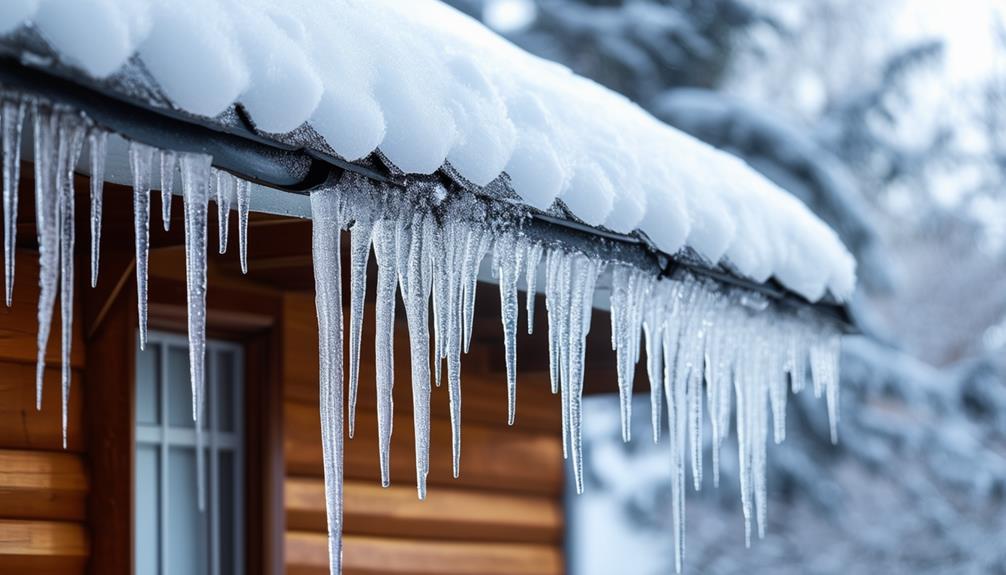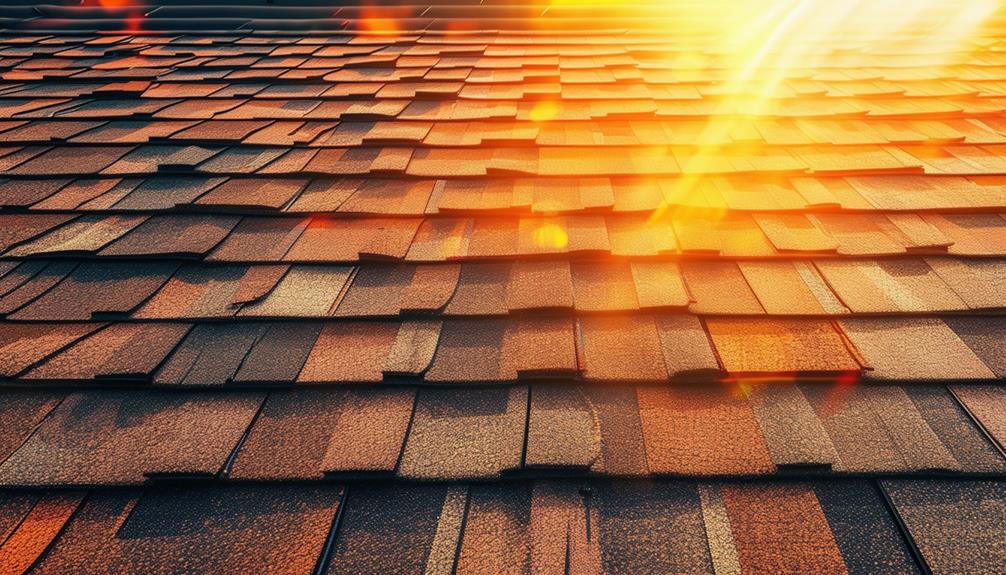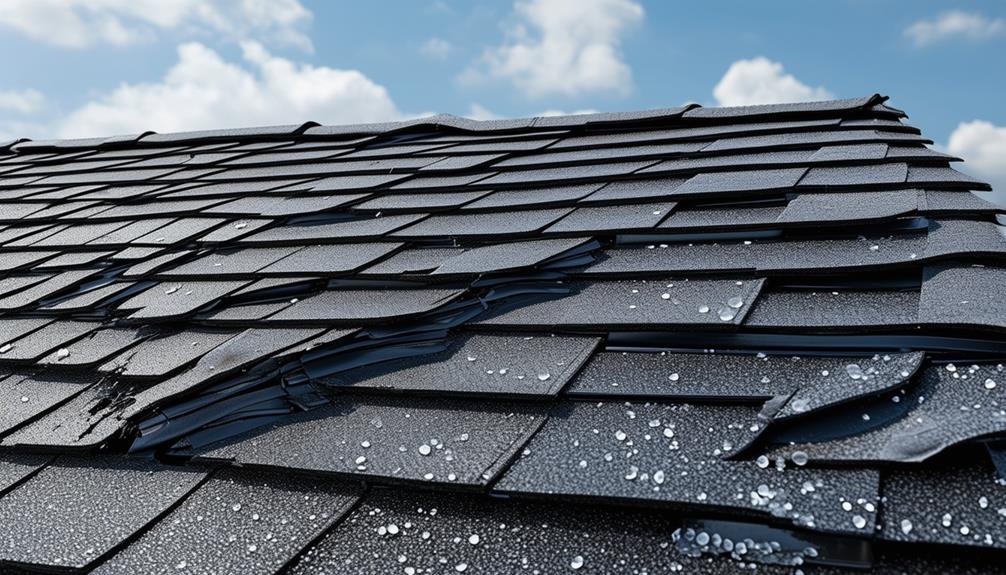Weather impacts your roof year-round. Winter brings heavy snow and freezing temps, leading to ice damming. Spring rains require prevention of water damage and wind-resistant roofing. Summer's UV rays need protective coatings and proper ventilation for heat dissipation. In the fall, leaves and debris pose risks, demanding gutter maintenance and debris removal. Be proactive with roof care to prevent issues and maintain longevity.
Winter: Snow, Ice, and Freezing Temperatures

In winter, heavy snow, ice buildup, and freezing temperatures can greatly impact the condition of your roof. To prevent ice damming, it is important to guarantee proper insulation and ventilation in your attic. Additionally, regular snow removal from your roof can help prevent excess weight that may lead to structural damage. Conducting winter roof inspections is vital to identify any issues early on. During these inspections, focus on roof de-icing methods to prevent ice dams from forming.
When it comes to roof de-icing, using calcium chloride can be an effective method to melt ice and snow without causing damage to your roof. However, it is important to follow safety precautions and avoid using rock salt, as it can be harmful to both your roof and the environment. Remember, proactive maintenance during winter can help extend the lifespan of your roof and prevent costly repairs.
Spring: Rain, Wind, and Pollen
As spring arrives, prepare your roof for the rainy season by implementing strategies to prevent water damage. Consider wind-resistant roofing options to safeguard your home against strong gusts that often accompany spring storms. Additionally, equip yourself with pollen cleaning tips to maintain the health and longevity of your roof during this blooming season.
Rainwater Damage Prevention
Prepare your roof for the spring rain, wind, and pollen by implementing effective strategies to prevent rainwater damage. Start by ensuring your gutters are clear of debris through regular maintenance. Clogged gutters can lead to water overflow, causing potential leaks and damage to your roof. Consider installing gutter guards to prevent blockages and maintain proper water flow.
In addition to gutter maintenance, explore drainage solutions to redirect rainwater away from your roof and foundation. Downspouts should extend at least 5 feet away from your home to prevent pooling water that could seep into your roof or basement. Waterproof sealants and roof coatings are also essential in protecting your roof from water infiltration. These materials create a barrier against moisture, preventing water from seeping through shingles or roof joints.
Wind-Resistant Roofing Options
Explore durable roofing materials designed to withstand high winds and protect your home during the spring season's unpredictable weather conditions. When contemplating wind-resistant roofing options, prioritize energy efficiency and sustainability to guarantee long-lasting protection for your home. Opting for energy-efficient roofing materials not only aids in reducing utility costs but also minimizes your environmental footprint. Look for sustainable materials like metal roofing, which is renowned for its durability and resistance to high winds. Metal roofs are lightweight yet incredibly strong, making them an excellent choice for enduring turbulent spring weather. Additionally, metal roofs are recyclable, adding to their eco-friendly appeal.
Another wind-resistant roofing option to ponder is impact-resistant shingles. These shingles are designed to withstand strong winds and resist damage from flying debris, common during spring storms. By investing in wind-resistant roofing materials that are energy efficient and made from sustainable sources, you can safeguard your home while also contributing to a greener environment.
Pollen Cleaning Tips
Spring brings a flurry of pollen, necessitating effective cleaning strategies to maintain the exterior of your home. To keep your roof free from pollen buildup, regular cleaning is essential. Pollen not only affects the appearance of your roof but can also lead to issues like algae growth if left unattended. When cleaning, use a gentle cleaning solution and a soft brush to prevent any damage to the roof's surface.
For allergy relief, it's vital to keep the pollen levels around your home to a minimum. In addition to cleaning your roof, consider investing in air purifiers and regularly changing your HVAC filters to reduce pollen indoors. Garden maintenance is also key; keep plants trimmed and tidy to minimize pollen production. Consider planting low-pollen varieties to mitigate pollen levels in your garden.
Summer: UV Rays and Heat Waves

Summer brings intense UV rays that can damage your roof over time, causing shingles to deteriorate and lose their protective properties. Heat waves during the summer can also impact your roof's performance, potentially leading to issues like thermal expansion and contraction. To keep your roof in top shape during the summer months, it's essential to implement proactive maintenance measures and consider UV protection strategies.
UV Damage Prevention
Protect your roof from the damaging effects of UV rays and heat waves during the summer months by implementing preventative measures. One effective way to shield your roof from UV damage is by applying a roof coating. Roof coatings act as a protective barrier, reflecting a significant portion of the sun's rays away from the roof surface. This helps in reducing heat absorption, which can prevent premature deterioration of roofing materials.
Another option to explore is using a protective film specifically designed to block UV rays. These films are easy to install and can provide an additional layer of defense against the sun's harmful effects. By incorporating either a roof coating or a protective film into your maintenance routine, you can prolong the lifespan of your roof and reduce the risk of UV-related damage.
Remember to inspect your roof regularly for signs of wear and tear, especially after periods of intense sunlight exposure. By taking proactive steps to defend against UV damage, you can keep your roof in excellent condition throughout the summer months.
Heat Wave Impact
Implementing proactive measures to mitigate the impact of heat waves, particularly UV rays, on your roof is essential for maintaining its longevity and durability. During a heat wave, your roof is exposed to intense sunlight and high temperatures, which can accelerate deterioration if not properly addressed. Proper roof ventilation is vital in dissipating heat buildup and preventing damage to roofing materials. Adequate ventilation allows hot air to escape, reducing the strain on your roof's structure and helping to regulate indoor temperatures.
Additionally, choosing the right insulation materials plays a significant role in protecting your roof from heat-related issues. High-quality insulation helps in maintaining a stable indoor climate by minimizing heat transfer through the roof. This not only enhances your comfort but also reduces the workload on your cooling system, leading to energy savings in the long run.
Summer Roof Maintenance
To safeguard your roof against the damaging effects of UV rays and heat waves during the summer months, proactive maintenance is essential. Here are some important tasks to keep your roof in top condition:
- Gutter Cleaning: Clear debris and leaves from gutters to make sure proper drainage and prevent water buildup, especially during summer storms.
- Shingle Inspection: Check for any cracked, loose, or missing shingles that could leave your roof vulnerable to UV damage and leaks.
- Trim Overhanging Branches: Trim back any branches hanging over your roof to prevent damage from falling limbs and debris.
- Attic Ventilation Check: Verify your attic is well ventilated to reduce heat buildup, which can warp shingles and increase energy costs.
Fall: Leaves, Debris, and Rain
During the fall season, your roof faces increased risks from leaves, debris, and heavy rain. Proper gutter maintenance is essential during this time to prevent water damage. Clogged gutters can lead to water pooling on your roof, causing leaks and potential structural issues. Make sure to clean out your gutters regularly to guarantee proper water flow.
Additionally, leaf removal is vital to keep your roof in good condition. Leaves can trap moisture, leading to rot and decay on your roof's surface. Schedule regular roof inspections to check for any debris buildup and promptly remove any leaves or branches that may have accumulated.
As the fall season brings heavier rainfall, it is crucial to address any existing roof issues promptly. Leaks or weak spots can worsen with the added moisture, leading to more significant problems down the line. Stay proactive in maintaining your roof during the fall to safeguard its longevity and durability through the changing weather conditions.
Extreme Weather: Hurricanes, Tornadoes, and Hail

Extreme weather events such as hurricanes, tornadoes, and hail pose significant threats to the integrity of your roof. When facing these natural disasters, it's important to take proactive measures to protect your home. Here's what you need to know: Extreme weather events such as hurricanes, tornadoes, and hail pose significant threats to the integrity of your roof. When facing these natural disasters, it’s important to take proactive measures to protect your home. Here’s what you need to know: staying informed about the latest roofing industry updates can help you choose durable materials and advanced solutions designed to withstand harsh conditions. Additionally, scheduling regular inspections with a licensed professional ensures that any minor damage is addressed before severe weather makes it worse. Proactive maintenance is key to avoiding costly repairs in the future.
- Roof reinforcement: Prioritize reinforcing your roof to withstand the high winds and heavy impacts associated with hurricanes, tornadoes, and hail. Consider installing impact-resistant materials and securing your roof's structure to minimize damage.
- Insurance coverage: Review your homeowner's insurance policy to make sure you have adequate coverage for extreme weather events. Understand the specific provisions related to roof damage caused by hurricanes, tornadoes, or hail, and consider additional coverage if needed.
- Regular inspections: Schedule regular roof inspections to identify and address any vulnerabilities before extreme weather strikes. Detecting issues early can help prevent extensive damage during a storm.
- Emergency response plan: Develop an emergency response plan that includes procedures for securing your roof and property in the event of a hurricane, tornado, or hailstorm. Stay informed and prepared to mitigate potential risks to your roof.
Tips for Winterizing Your Roof
Prepare your roof for the winter season with these essential tips to guarantee its durability and resilience against cold weather conditions. Start by checking your roof insulation. Important insulation plays a vital role in maintaining a consistent temperature in your home and preventing heat loss through the roof. Adequate insulation can also help in reducing the formation of ice dams on your roof.
Ice dams are ridges of ice that form at the edge of a roof, preventing melting snow from properly draining off. To prevent ice dams, make sure your attic is well-insulated to maintain a cool temperature and prevent snow from melting unevenly on the roof, which can contribute to ice dam formation. Additionally, make sure your roof is clear of debris and that the gutters are clean to allow for proper water drainage.
Tips for Spring Roof Maintenance

To guarantee the longevity and performance of your roof, conducting spring maintenance is essential for addressing any potential issues before they escalate. As the weather warms up, it's the perfect time to give your roof the attention it needs to stay in top condition. Here are some key tips for spring roof maintenance:
- Gutter Cleaning: Remove any debris that has accumulated in your gutters over the winter months. Clogged gutters can lead to water backup and damage to your roof.
- Shingle Inspection: Check for any loose, damaged, or missing shingles. Replace or repair them promptly to prevent leaks and further roof damage.
- Trim Overhanging Branches: Trim back any tree branches that are hanging over your roof. These can cause damage to shingles and invite critters onto your roof.
- Check for Signs of Water Damage: Look for water stains on your ceiling or walls, as these can indicate a roofing issue. Address any water damage promptly to prevent further problems.
Year-Round Roof Care Advice
Regular roof maintenance throughout the year is essential to guarantee the longevity and performance of your roof. One important aspect of year-round roof care is conducting regular roof inspections. These inspections help identify any issues promptly, such as loose shingles, damaged flashing, or clogged gutters, before they escalate into more significant problems. It is advisable to schedule a professional roof inspection at least twice a year, ideally in the spring and fall, to make sure your roof remains in top condition.
In addition to regular roof inspections, establishing a maintenance schedule can help you stay proactive in caring for your roof. Create a checklist that includes tasks such as cleaning gutters, trimming overhanging branches, checking for signs of water damage, and ensuring proper attic ventilation. By adhering to a maintenance schedule, you can address minor issues promptly and prevent costly repairs down the line. Remember, a well-maintained roof is key to protecting your home from the elements and maintaining its structural integrity.
Frequently Asked Questions
Can Extreme Weather Damage My Roof Even With Regular Maintenance?
Yes, essential weather can still damage your roof, even with regular maintenance. Roof snowstorms and hail damage are common culprits. Despite your efforts, strong winds, heavy snow, and hail can cause significant harm to your roof. It's important to stay vigilant and promptly address any signs of damage to prevent costly repairs later on. Regular inspections and timely repairs are key to protecting your roof from severe weather conditions.
How Can I Prevent Roof Leaks During Heavy Rainstorms?
To prevent roof leaks during heavy rainstorms, prioritize roof maintenance. Keep gutters clear of debris to guarantee proper water drainage. Check for any loose or missing shingles that could lead to leaks. Consider applying a waterproof sealant to your roof for added protection. Regular inspections and repairs can help safeguard your roof against the elements, keeping your home dry and secure during heavy rainstorms.
Is It Necessary to Inspect My Roof After a Mild Earthquake?
After an earthquake, roof maintenance is vital. Inspecting your roof post-earthquake is necessary to guarantee its structural integrity. Even a mild earthquake can cause damage that's not immediately visible. Look for signs of shifted or cracked shingles, loose flashing, or weakened areas. Addressing these issues promptly can prevent leaks and further damage. Regular inspections after seismic activity can help you catch problems early and protect your home from potential roof issues.
What Steps Should I Take to Protect My Roof From Wildfires?
To shield your roof from wildfires, opt for fire-resistant materials. Guarantee your roof is well-maintained by regularly inspecting for any damage or debris buildup. Clear any flammable vegetation near your home and keep your gutters clean. Consider installing spark arrestors on chimneys and vents. These steps can fortify your roof against potential fire hazards and enhance its resilience in the face of wildfires.
Are There Any Special Considerations for Roofing in High-Altitude Areas?
When living in high-altitude areas, consider the impact of snow accumulation on your roof. Opt for roofing materials designed to withstand heavy snow loads. Make sure your roof has proper wind resistance features and a suitable design to prevent damage from high winds common in elevated locations. Prioritize durability and weather-resistance when selecting roofing materials to protect your home in these challenging environments.
Conclusion
In summary, maintaining your roof throughout the year is essential for protecting your home from the elements. By following the tips and advice provided, you can guarantee your roof remains in top condition no matter the weather. Remember, a well-maintained roof is a key investment in the longevity and safety of your home. So, whether it's winter snow or summer heat, stay ahead of the weather and keep your roof in tip-top shape for years to come.




